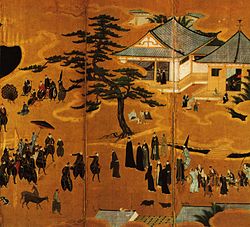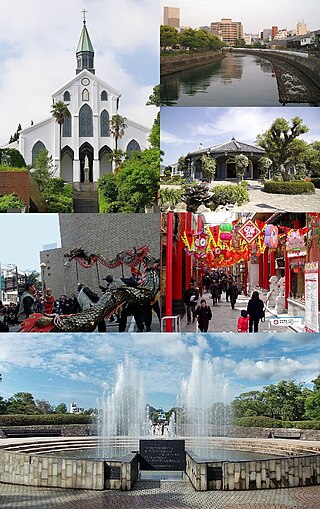
Nagasaki is the capital and the largest city of Nagasaki Prefecture on the island of Kyushu in Japan.

Luís Fróis was a Portuguese missionary who worked in Asia during the second half of the 16th century. While in Japan in 1582, he witnessed the attack on Honnō-ji, a Buddhist temple that ended in the death of Oda Nobunaga.

The Japanese term Kirishitan, from Portuguese cristão, meaning "Christian", referred to Catholic Christians in Japanese and is used in Japanese texts as a historiographic term for Catholics in Japan in the 16th and 17th centuries.
Gaspar Coelho was a Portuguese Jesuit missionary. He replaced Francisco Cabral as the Superior and Vice-Provincial of the Jesuit mission in Japan during the late 16th century. He catalyzed the disfavor of Toyotomi Hideyoshi against the Jesuit mission in Japan in 1587.
Arima Harunobu was a Japanese samurai lord who was the daimyo of Shimabara Domain and the head of the Hizen-Arima clan. In his early years, he was a retainer of Ryūzōji clan.

Ōmura Sumitada was a Japanese daimyō lord of the Sengoku period. He achieved fame throughout the country for being the first of the daimyo to convert to Christianity following the arrival of the Jesuit missionaries in the mid-16th century. Following his baptism, he became known as "Dom Bartolomeu". Sumitada is also known as the lord who opened the port of Nagasaki to foreign trade.
Cosme de Torres was a Spanish Jesuit from Valencia and one of the first Christian missionaries in Japan. He was born in Valencia and died in Amakusa, an island now in Kumamoto Prefecture, Japan.
Ōmura Yoshiaki was a ruling head of the clan of Ōmura throughout the latter Sengoku period of Feudal Japan. As Yoshiaki was the respective son of Ōmura Sumitada, he followed his father in succession at some variable time, at which relations with the Jesuits and trade with the Portuguese had been already firmly developed.

Matsura Takanobu or Taqua Nombo was a 16th-century Japanese samurai and 25th hereditary lord of the Matsura clan of Hirado. He was one of the most powerful feudal lords of Kyūshū and one of the first to allow trading with Europeans, particularly the Portuguese, through whom he amassed great profits in the import of western firearms. He was also an early host and patron to the Jesuits, who he hoped would help secure an increase in trade with the Portuguese and other European traders.
Ōmura Domain was a Japanese domain of the Edo period. It is associated with Hizen Province in modern-day Saga Prefecture.
Christian missionaries arrived with Francis Xavier and the Jesuits in the 1540s and briefly flourished, with over 100,000 converts, including many daimyōs in Kyushu. It soon met resistance from the highest office holders of Japan. Emperor Ōgimachi issued edicts to ban Catholicism in 1565 and 1568, but to little effect. Beginning in 1587, with imperial regent Toyotomi Hideyoshi's ban on Jesuit missionaries, Christianity was repressed as a threat to national unity. After the Tokugawa shogunate banned Christianity in 1620 it ceased to exist publicly. Many Catholics went underground, becoming hidden Christians, while others lost their lives. Only after the Meiji Restoration was Christianity re-established in Japan.

St. Paul's College of Macau also known as College of Madre de Deus was a university founded in 1594 in Macau by Jesuits at the service of the Portuguese under the Padroado treaty. It claims the title of the first Western university in East Asia.
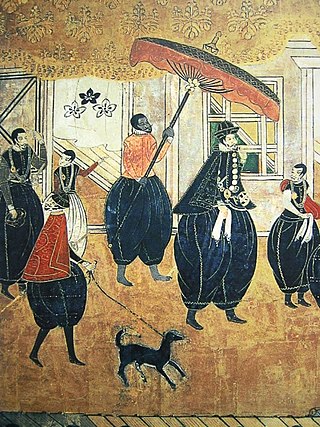
Nanban trade or the Nanban trade period, was a period in the history of Japan from the arrival of Europeans in 1543 to the first Sakoku Seclusion Edicts of isolationism in 1614. Nanban is a Japanese word which had been used to designate people from Southern China, Ryukyu islands, Indian Ocean and Southeast Asia centuries prior to the arrival of the first Europeans. For instance, according to the Nihongi ryaku (日本紀略), Dazaifu, the administrative center of Kyūshū, reported that the Nanban pirates, who were identified as Amami islanders by the Shōyūki, pillaged a wide area of Kyūshū in 997. In response, Dazaifu ordered Kikaijima (貴駕島) to arrest the Nanban.
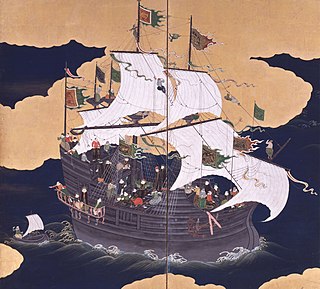
The Battle of Fukuda Bay in 1565 was the first recorded naval battle between Europeans and the Japanese. A flotilla of samurai under the daimyō Matsura Takanobu attacked two Portuguese trade vessels that had shunned Matsura's port in Hirado and had gone instead to trade at Fukuda, a port belonging to the rival Ōmura Sumitada. The engagement was part of a process of trial and error by the Portuguese traders to find a safe harbour for their carracks in Japan that eventually brought them to Nagasaki.
Fukuda was a village in Nishisonogi District, Nagasaki Prefecture. It was absorbed into Nagasaki city in 1955.
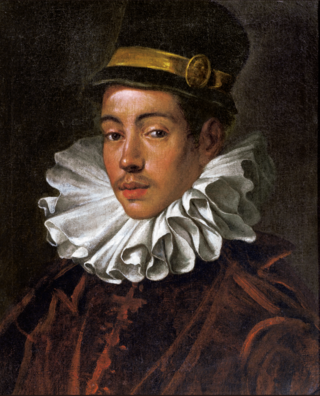
Itō Mancio was a Japanese Jesuit, head of the Tenshō embassy; the first Japanese diplomatic mission to Europe, and a Catholic priest.

Yokoseura (横瀬浦) is a port located at the northern tip of the Nishisonogi Peninsula on the Japanese island of Kyushu, administratively under Saikai city, Nagasaki Prefecture. It was developed as an entrepot by the Portuguese in 1562 with the permission of the local lord Ōmura Sumitada, but was burned down a year later during a rebellion against Sumitada.
Myōrin (妙林) or YoshiokaMyorin-ni (吉岡妙林尼) was a late-Sengoku period female warlord onna-musha. She was the wife of Yoshioka Akioki a samurai warlord, and served Otomo clan in Bungo. She was the heroic woman who defended the Otomo clan in the Kyūshū campaign against Shimazu's army. Her contributions to the Kyushu campaign were so significant that they completely changed the course of history and she was highly praised by Japan's most powerful man at the time, Toyotomi Hideyoshi. Later, she was named Guardian of Tsurusaki, an honorary title due to her heroic acts.

Gaspar Vilela or Gaspar Villela, was a priest and Jesuit missionary, and his activity in Japan influenced the Portuguese and Christian presence.


